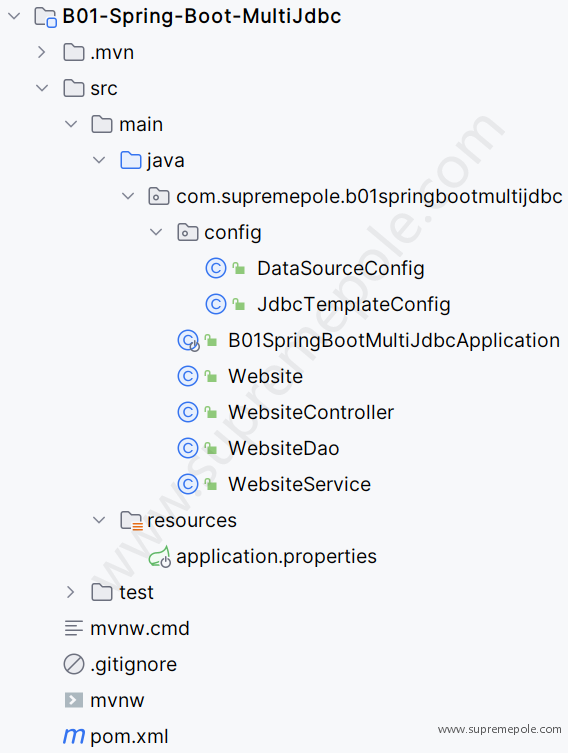Spring Boot与JDBC多数据源
Spring Boot与JDBC多数据源
介绍
在Spring Boot中,如果你需要使用多个数据源(例如连接到不同的数据库),你可以通过配置多个JdbcTemplate实例来实现。
下面是Spring Boot与JdbcTemplate多数据源的整合步骤:
添加依赖:在你的Spring Boot项目的
pom.xml文件中添加JdbcTemplate的依赖,如之前所述。配置数据源:在
application.properties(或application.yml)文件中配置多个数据源的连接信息。你可以为每个数据源指定不同的前缀,例如:# 第一个数据源 spring.datasource.datasource1.url=jdbc:mysql://localhost:3306/database1 spring.datasource.datasource1.username=username1 spring.datasource.datasource1.password=password1 spring.datasource.datasource1.driver-class-name=com.mysql.jdbc.Driver # 第二个数据源 spring.datasource.datasource2.url=jdbc:mysql://localhost:3306/database2 spring.datasource.datasource2.username=username2 spring.datasource.datasource2.password=password2 spring.datasource.datasource2.driver-class-name=com.mysql.jdbc.Driver创建数据源和JdbcTemplate Bean:在Spring Boot的配置类中创建多个数据源和对应的JdbcTemplate Bean。你可以使用
@Configuration注解和@Bean注解分别创建数据源和JdbcTemplate Bean,并分别给它们命名。@Configuration public class DatabaseConfig { @Primary @Bean(name = "dataSource1") @ConfigurationProperties(prefix = "spring.datasource.datasource1") public DataSource dataSource1() { return DataSourceBuilder.create().build(); } @Bean(name = "jdbcTemplate1") public JdbcTemplate jdbcTemplate1(@Qualifier("dataSource1") DataSource dataSource1) { return new JdbcTemplate(dataSource1); } @Bean(name = "dataSource2") @ConfigurationProperties(prefix = "spring.datasource.datasource2") public DataSource dataSource2() { return DataSourceBuilder.create().build(); } @Bean(name = "jdbcTemplate2") public JdbcTemplate jdbcTemplate2(@Qualifier("dataSource2") DataSource dataSource2) { return new JdbcTemplate(dataSource2); } }在上面的示例中,我们创建了两个数据源(
dataSource1和dataSource2)以及对应的JdbcTemplate实例(jdbcTemplate1和jdbcTemplate2)。@Primary注解用于指定默认的数据源。使用JdbcTemplate:在需要使用JdbcTemplate的地方注入对应的JdbcTemplate实例,并使用其提供的方法执行数据库操作。
@Autowired @Qualifier("jdbcTemplate1") private JdbcTemplate jdbcTemplate1; @Autowired @Qualifier("jdbcTemplate2") private JdbcTemplate jdbcTemplate2; public void fetchUsers() { List<Map<String, Object>> userList1 = jdbcTemplate1.queryForList("SELECT * FROM users"); for (Map<String, Object> user : userList1) { System.out.println("User from dataSource1: " + user.get("username")); } List<Map<String, Object>> userList2 = jdbcTemplate2.queryForList("SELECT * FROM users"); for (Map<String, Object> user : userList2) { System.out.println("User from dataSource2: " + user.get("username")); } }
Demo
项目结构

项目源码
import org.springframework.boot.SpringApplication;
import org.springframework.boot.autoconfigure.SpringBootApplication;
@SpringBootApplication
public class B01SpringBootMultiJdbcApplication {
public static void main(String[] args) {
SpringApplication.run(B01SpringBootMultiJdbcApplication.class, args);
}
}
import com.alibaba.druid.spring.boot.autoconfigure.DruidDataSourceBuilder;
import org.springframework.boot.context.properties.ConfigurationProperties;
import org.springframework.context.annotation.Bean;
import org.springframework.context.annotation.Configuration;
import org.springframework.context.annotation.Primary;
import javax.sql.DataSource;
/**
* CodeCoderCoding
*/
@Configuration
public class DataSourceConfig {
@Bean
@ConfigurationProperties("spring.datasource.one")
@Primary
DataSource dsOne() {
return DruidDataSourceBuilder.create().build();
}
@Bean
@ConfigurationProperties("spring.datasource.two")
DataSource dsTwo() {
return DruidDataSourceBuilder.create().build();
}
}
import org.springframework.beans.factory.annotation.Qualifier;
import org.springframework.context.annotation.Bean;
import org.springframework.context.annotation.Configuration;
import org.springframework.jdbc.core.JdbcTemplate;
import javax.sql.DataSource;
/**
* @author CodeCoderCoding
*/
@Configuration
public class JdbcTemplateConfig {
@Bean
JdbcTemplate jdbcTemplateOne(@Qualifier("dsOne") DataSource dataSource){
return new JdbcTemplate(dataSource);
}
@Bean
JdbcTemplate jdbcTemplateTwo(@Qualifier("dsTwo") DataSource dataSource){
return new JdbcTemplate(dataSource);
}
}
import org.springframework.beans.factory.annotation.Autowired;
import org.springframework.web.bind.annotation.GetMapping;
import org.springframework.web.bind.annotation.RestController;
/**
* @author CodeCoderCoding
*/
@RestController
public class WebsiteController {
@Autowired
WebsiteService websiteService;
@GetMapping("/add-website")
public void addWebsite(){
Website website=new Website();
website.setId(1);
website.setName("supremepole");
website.setUrl("https://cs.supremepole.com");
websiteService.addWebsite(website);
Website website2=new Website();
website2.setId(2);
website2.setName("supremepole interview");
website2.setUrl("https://interview.supremepole.com");
websiteService.addWebsite(website2);
}
@GetMapping("/get-website")
public Website getWebsite(){
return websiteService.getWebsiteById(1);
}
@GetMapping("/update-website")
public void updateWebsite(){
Website website=new Website();
website.setId(1);
website.setName("supremepole algorithm");
website.setUrl("https://algorithm.supremepole.com");
websiteService.updateWebsite(website);
}
@GetMapping("/delete-website")
public void deleteWebsite(){
websiteService.deleteWebsiteById(2);
}
}
import org.springframework.beans.factory.annotation.Autowired;
import org.springframework.stereotype.Service;
import java.util.List;
/**
* @author CodeCoderCoding
*/
@Service
public class WebsiteService {
@Autowired
WebsiteDao websiteDao;
public int addWebsite(Website website) {
return websiteDao.addWebsite(website);
}
public int updateWebsite(Website book) {
return websiteDao.updateWebsite(book);
}
public int deleteWebsiteById(Integer id) {
return websiteDao.deleteWebsiteById(id);
}
public Website getWebsiteById(Integer id) {
return websiteDao.getWebsiteById(id);
}
public List<Website> getAllWebsites() {
return websiteDao.getAllWebsites();
}
}
package com.supremepole.b01springbootmultijdbc;
import org.springframework.beans.factory.annotation.Autowired;
import org.springframework.jdbc.core.BeanPropertyRowMapper;
import org.springframework.jdbc.core.JdbcTemplate;
import org.springframework.stereotype.Repository;
import javax.annotation.Resource;
import java.util.List;
/**
* @author CodeCoderCoding
*/
@Repository
public class WebsiteDao {
@Resource(name="jdbcTemplateOne")
JdbcTemplate jdbcTemplateOne;
@Resource(name="jdbcTemplateTwo")
JdbcTemplate jdbcTemplateTwo;
public int addWebsite(Website website) {
return jdbcTemplateTwo.update("INSERT INTO website(id,name,url) VALUES (?,?,?)",
website.getId(), website.getName(), website.getUrl());
}
public int updateWebsite(Website website) {
return jdbcTemplateTwo.update("UPDATE website SET name=?,url=? WHERE id=?",
website.getName(), website.getUrl(), website.getId());
}
public int deleteWebsiteById(Integer id) {
return jdbcTemplateTwo.update("DELETE FROM website WHERE id=?", id);
}
public Website getWebsiteById(Integer id) {
return jdbcTemplateOne.queryForObject("select * from website where id=?",
new BeanPropertyRowMapper<>(Website.class), id);
}
public List<Website> getAllWebsites() {
return jdbcTemplateOne.query("select * from website",
new BeanPropertyRowMapper<>(Website.class));
}
}
package com.supremepole.b01springbootmultijdbc;
/**
* @author CodeCoderCoding
*/
public class Website {
private int id;
private String url;
private String name;
public int getId() {
return id;
}
public void setId(int id) {
this.id = id;
}
public String getUrl() {
return url;
}
public void setUrl(String url) {
this.url = url;
}
public String getName() {
return name;
}
public void setName(String name) {
this.name = name;
}
@Override
public String toString(){
return "id="+id+" ,name"+name+" ,url"+url;
}
}
server.port=8081
# 数据源1
spring.datasource.one.type=com.alibaba.druid.pool.DruidDataSource
spring.datasource.one.driver-class-name=com.mysql.cj.jdbc.Driver
spring.datasource.one.url=jdbc:mysql://localhost:3306/spring-demo?useUnicode=true&characterEncoding=UTF-8&autoReconnect=true&useSSL=false
spring.datasource.one.username=root
spring.datasource.one.password=123456
# 数据源2
spring.datasource.two.type=com.alibaba.druid.pool.DruidDataSource
spring.datasource.two.driver-class-name=com.mysql.cj.jdbc.Driver
spring.datasource.two.url=jdbc:mysql://localhost:3306/spring-demo2?useUnicode=true&characterEncoding=UTF-8&autoReconnect=true&useSSL=false
spring.datasource.two.username=root
spring.datasource.two.password=123456
spring.jpa.properties.database=mysql
spring.jpa.properties.hibernate.hbm2ddl.auto=update
spring.jpa.properties.show-sql= true
